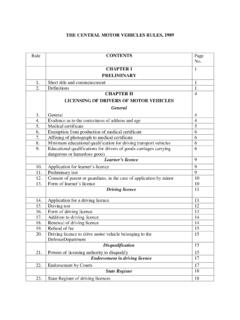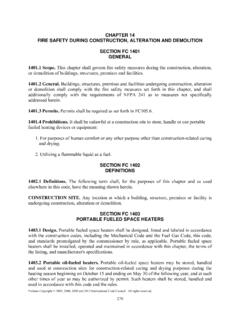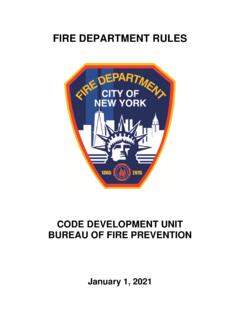Transcription of CHAPTER 8 SPECIALISED SHIPS, TANKERS, CHEMICAL …
1 CHAPTER 8 SPECIALISED SHIPS, TANKERS, CHEMICAL CARRIERS, liquefied GAS CARRIERS, DANGEROUS GOODS AND OFFSHORE INSTALLATIONS CHAPTER 8 .. 1 SPECIALISED SHIPS, TANKERS, CHEMICAL CARRIERS, liquefied GAS CARRIERS, DANGEROUS GOODS AND OFFSHORE 1 FIRE SAFETY MEASURES FOR TANKERS .. 2 Application .. 2 CHEMICAL Tankers .. 2 liquefied Gas 2 Location and separation of 3 Venting, purging, gas-freeing and ventilation .. 6 Ignition 8 Fixed deck foam 11 Fixed dry powder 11 Protection of cargo pump rooms .. 11 Instruments for measuring oxygen and flammable vapour 13 INERT GAS 15 Oil and petroleum 15 CHEMICAL tankers and gas 15 Isolation arrangements in inert gas 16 Testing.
2 17 SPECIAL REQUIREMENTS FOR SHIPS CARRYING DANGEROUS GOODS .. 18 Statutory requirements .. 18 18 Fire 18 Sources of ignition .. 20 Ventilation .. 20 Insulation of machinery space boundaries .. 22 Personnel 22 SHIPS CARRYING 23 VEHICLE, SPECIAL CATEGORY AND RO-RO 23 Fire 23 Sources of ignition .. 23 Ventilation .. 24 Horizontal fire zone concept .. 25 OFFSHORE SUPPORT VESSELS .. 25 Carriage of flammable liquids .. 25 Carriage of dangerous goods and noxious liquids .. 25 MSIS 12/CH 8/REV 0909/PAGE 1 Fire safety measures for tankers Application This section concerns details, relevant to fire protection on tankers and tanker safety as a whole, which are not specifically dealt with elsewhere in these Instructions or in the regulations.
3 It may also be applicable to ships which are not normally operated as tankers but which may be engaged in the carriage of flammable liquids in bulk. SOLAS I Reg 2 defines a tanker as a cargo ship constructed or adapted for the carriage in bulk of liquid cargoes of an inflammable1 nature . SOLAS II-2 Reg clarifies the meaning of inflammable/flammable by stating Requirements for tankers in this CHAPTER shall apply to tankers carrying crude oil or petroleum products having a flashpoint not exceeding 60 C (closed cup test), as determined by an approved flashpoint apparatus, and a Reid vapour pressure which is below the atmospheric pressure or other liquid products having a similar fire hazard (the MS (Large ) Regulations call these category A tankers) The same definitions can be assumed for non SOLAS ships.
4 In matters of tanker safety reference should be made to the 'International Safety Guide for Oil Tankers and Terminals' (ISGOTT Guide) published by the International Chamber of Shipping, Oil Companies International Marine Forum and the International Association of Ports and Harbours. CHEMICAL TANKERS These Instructions apply in general to CHEMICAL tankers although provisions of the 'Code for the Construction and Equipment of Ships carrying Dangerous Chemicals in Bulk' or the 'International Code for the Construction and Equipment of Ships Dangerous Chemicals in Bulk' as appropriate should be taken into account, see the Instructions to Surveyors on CHEMICAL Tankers. Should any difficulty arise in complying with both the regulations and the above Codes the matter should be referred to the appropriate Headquarters Branch.
5 liquefied GAS CARRIERS liquefied gas carriers which have a valid certificate of fitness need not be provided with a fixed deck foam system or an inert gas system other than as required in accordance with the provisions of the 'Code for the Construction and Equipment of Ships carrying liquefied Gases in Bulk' or the 'International Code for the Construction and Equipment of Ships carrying liquefied Gases in Bulk' as appropriate, see the Instructions to Surveyors on Gas Carriers. 1 "Inflammable" has the same meaning as "flammable" MSIS 12/CH 8/REV 0909/PAGE 2 Location and separation of spaces (ships constructed on or after 1 February 1992) The regulations place restrictions on the types of spaces which can be located near to cargo and slop tanks and requires separation from possible sources of flammable gases by a cofferdam, cargo pump room, oil fuel bunker or ballast tank.
6 Interpretations of these requirements follow: Construction of cofferdams and prohibition of containment of cargo, wastes and goods (SOLAS II-2 Reg. ): The expression cofferdam is meant, for the purposes of the regulations, an isolating space between two adjacent steel bulkheads or decks. The minimum distance between two bulkheads or decks, should be sufficient for safe access and inspection. In order to meet the single failure principle, in the particular case when a corner-to-corner situation occurs, this principle may be met by welding a diagonal plate across the corner (see figure below). No cargo, wastes or other goods should be contained in cofferdams. (Unified Interpretation - MSC/Circ.)
7 1120) CORNER-TO-CORNER SITUATION IN A COFFERDAM Safety aspects of double bottoms and duct keels under cargo oil tanks (SOLAS II-2 Reg. ): Pipe ducts in the double bottom shall comply with the following requirements: (i) They should not communicate with the engine room. (ii) Provision shall be made for at least two exits to the open deck arranged at a maximum distance from each other. One of these exits fitted with a watertight closure may lead to the cargo pumproom. MSIS 12/CH 8/REV 0909/PAGE 3 (iii) In the duct, provision shall be made for adequate mechanical ventilation. (IACS Unified Rule F 26) Separation of cargo oil tanks (SOLAS II-2 Reg. ): Pump-rooms intended solely for ballast transfer need not comply with the requirements of regulation The requirements of regulation are only applicable to the pumprooms where pumps for cargo, such as cargo pumps, stripping pumps, pumps for slop tanks, pumps for COW or similar pumps are provided.
8 (Unified Interpretation - MSC/Circ. 1120) Restriction on boundary openings (SOLAS II-2 Reg , IBC Code , IGC Code ) Access to forecastle spaces containing sources of ignition may be permitted through doors facing cargo area provided the doors are located outside hazardous areas as defined in IEC Publication 60092-502. (IACS Unified Interpretation SC 120) Cargo areas (SOLAS II-2 Reg and ) For ships constructed on or after 5 October 2007: 1 A void space or ballast water tank protecting a fuel oil tank, in accordance with MARPOL, as shown in figure 1, need not be considered as a cargo area as defined in SOLAS regulation II-2 even though they have a cruciform contact with the cargo oil tank or slop 2 The void space protecting a fuel oil tank, in accordance with MARPOL, is not considered as a cofferdam as specified in SOLAS regulation II-2 Therefore, location of the void space shown in figure 1 should be considered acceptable even though they have a cruciform contact with the slop tank.
9 2 As defined by MARPOL 73/78. MSIS 12/CH 8/REV 0909/PAGE 4 BALLAST WATER TANK (BWT) FUEL OIL TANK (FOT) CARGO OIL TANK (COT) Figure 1 (Unified Interpretation - MSC/Circ. 1239) Cargo openings in the bottoms of topside tanks of ships carrying alternatively oil and grain on ships carrying alternatively oil having a flash point not exceeding 60 C (closed cup test) or other cargoes. When ships are designed to transport alternatively oil or dry cargoes, openings which may be used for cargo operations are not permitted in bulkheads and decks separating oil cargo spaces from other spaces not designed and equipped for the carriage of oil cargoes unless alternative approved means are provided to ensure equivalent integrity.
10 (IACS Unified Rule F 27) Bow and stern loading and unloading arrangements on oil tankers Where a cargo hose connection is arranged outside the cargo tank area, the pipe leading to such connections is to be provided with means of segregation such as a spectacle flange, removable spool piece or equivalent3 located within the cargo area. The space within 3 m of the manifold is to be considered as a dangerous area with regard to electrical or incendive equipment. (IACS Unified rule F 16) Fore peak ballast system on oil tankers 3 See MSC/Circ. 474. MSIS 12/CH 8/REV 0909/PAGE 5 The fore peak can be ballasted with the system serving ballast tanks within the cargo area, provided : The tank is considered as hazardous; The vent pipe openings are located on open deck 3 m away from sources of ignition; Means are provided, on the open deck, to allow measurement of flammable gas concentrations within the tank by a suitable portable instrument; The access to the fore peak and sounding arrangements are direct from open deck.












